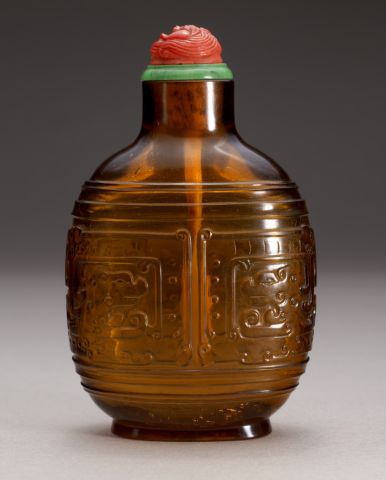
Bottle ID: 00666
AMBER, TRANSPARENT, CARVED W/CENTRAL BAND OF DRAGONS & MARK
Date: 1780-1850
Height: 69 mm
Glass, clear amber-brown tone, of large ovoid form with rounded shoulders, carved in relief with a continous horizontal central band of stylized archaic confronted dragons between concentric concave bands; the flat base with a four character Qianlong nianzhi wheel-cut mark.
Similar Examples:
Moss, Hugh, Victor Graham and Ka Bo Tsang. A Treasury of Chinese Snuff Bottles - The Mary and George Bloch Collection, 2002, Vol. 5, Part 2, pp. 331-333, no. 821.
Hui, Humphrey K. F., Margaret Polak, and Christopher C. H. Sin. Hidden Treasures of the Dragon - Chinese Snuff Bottles from the Collections of Humphrey K. F. Hui, Margaret Polak, and Christopher C. H. Sin, 1991, p. 126, no. 257.
Sotheby's, New York, September 17, 1996, lot 180, Collection of Gerd Lester.
Provenance:
Hugh Moss [HK] Ltd.
Exhibited:
Annual Convention ICSBS Toronto, October 2007
It is clear from the Archives of the Imperial Household Department during the Qianlong period that many snuff bottles were produced in the Palace Workshops for a variety of people ranging from the Emperor and his family, who were known snuff takers, to officials hoping to curry favor within the Court. Snuff bottles were also produced in large numbers throughout the reign for a variety of other reasons. Glass bottles were produced annually for different festivals, for example, in a number of different years the Archives state:
"Make for New Year Festival" (1739, 1742).
and
"To present for Duanyang Festival". (1741, 1745).
For such festivals glass bottles were ordered in groups of fifty or sixty at a time.
The glass workshops also produced bottles in lesser numbers and presumably of a higher quality for bestowal on the neighboring Lamas. In 1745, four glass bottles were made for bestowal on the Dalai Lama and another four for bestowal on the Banchan Lama in the same year. In 1775, four glass snuff bottles were orered to be made for bestowal on the Banchan Lama, showing that this practice contiued throughout the Qianlong period. In 1747, the Emperor ordered sixty bottles to be made in various colors for presentation on his birthday.
It is clear that early during the reign of the Qianlong Emperor, snuff bottles had already gained a following within the Court and that despite their exclusion from ceremonial affairs, they were an integral part of Court life and held in great esteem by all, to the extent that they were considered suitable tributes for presentation to other foreign leaders, even to religious leaders.
< Back to full list
 English
English 中文
中文